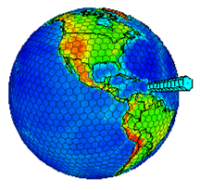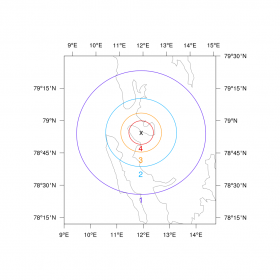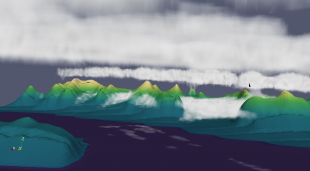doi: 10.5194/gmd-3-415-2010This is an old revision of the document!
Models
Our group use a wide range of numerical models of atmosphere, from regional models to large eddy simulations and single column models.
DALES
Dutch Atmospheric Large-Eddy Simulation (DALES) is the software package that we employ for fine modeling of cloud processes. We use for number of case models of convective cases as well as cases of stratiform clouds.
Our version of dales also includes Testbed for inserting forcing from observations and weather forecast models.
While the DALES 1) generally do not support mixed-phase clouds, we are currently working on implementing full 3-phase microphysics scheme of Seifert-Beheng 2)
ICON
Regional LES and Global climate simulation
We use the ICON (Icosahedral non-hydrostatic) model in two different version - the LES version ICON-LEM developed during the HDCP2 project and the general circulation model developed by the Max-Planck-Insitute for Meteorology (MPI) and the Germany Weather Service (DWD).
Apart from its innovative triangular grid, ICON has several advantages over existing models; in particular the combination of a non-hydrostatic core with the option of heterogeneous forcing and non-periodic boundaries creates ideal opportunities for research of scale-adaptive parameterizations. The setup allows to simulate various synoptic situations at different places and a reasonable comparison to observational data - with this the testbed-situations for parameterization development is growing and getting more variable. For the LES simulations forcing by the COSMO-DE or IFS model is used, which brings the information about the synoptic situation to the outer domain and coarsest resolution. Then the resolution is refined within several nests to actually reach a resolution that is able to resolve large eddies. For simulations around supersites we use at the moment a starting domain of 110km diameter and ca. 600m resolution, then three more nests are included ending with a resolution of ca. 75m (see Figure 1 for a setup around Ny Ålesund).
Figure 1. An impression on the ICON-LEM simulations around the Ny Ålesund meteorological site on Spitsbergen performed by the InScAPE group. The left panels shows the set of nested simulations, while the right panel shows a visualization of clouds and the included topography.
The general circulation model version is used for developing and testing parameterizations. At the moment our focus is on the development and implementation of a PDF cloud scheme. For more information on our development of the PDF cloud scheme, see here; more information about the GCM version of ICON can be found at the MPI website (ICON).
SCM

Single Column Modeling (SCM) is a technique in which only a single vertical column from the grid of a GCM is integrated forward in time. The boundary conditions and larger-scale forcings are prescribed, usually obtained from a larger-scale model and/or observations. The suite of subgrid-scale parameterizations of the GCM is free to act, and can create their own unique model state. This can give insight into the behavior of parameterization at process level, and can help in understanding model biases as diagnosed in a GCM.
While the highly reduced cost and enhanced transparency of SCM simulation are clear benefits, one should always be aware of its limitations. For example, the interaction with the larger-scale flow is exclusively one-way (down-scale). However, new techniques are being developed to allow the larger-scale flow to respond to the subgrid physics in SCM simulation. One of these makes use of the Weak Temperature Gradient (WTG) approximation in the tropics.
doi:10.1016/S0169-8095(01)00126-0

